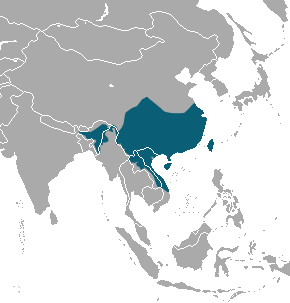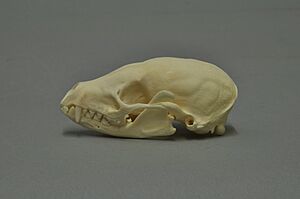Chinese ferret-badger facts for kids
Quick facts for kids Chinese ferret-badger |
|
|---|---|
 |
|
| At Prague Zoo. | |
| Conservation status | |
| Scientific classification | |
| Genus: |
Melogale
|
| Species: |
moschata
|
 |
|
| Chinese ferret-badger range (also includes Formosan ferret-badger in Taiwan) | |
| Synonyms | |
|
Helictis subaurantiaca |
|
The Chinese ferret-badger (Melogale moschata) is a small, furry animal. It is also called the small-toothed ferret-badger. This animal is part of the Mustelidae family, which includes weasels and otters. You can find them in many parts of Southeast Asia.
Scientists say the Chinese ferret-badger is a species of "Least Concern". This means there are still many of them in the wild. They can even live in places where humans have changed the habitat. These badgers live from Northeast India up to Central China. They also live south into northern Indochina. Another type, the Formosan ferret-badger from Taiwan, used to be thought of as the same species. But now, experts know it is a different kind of ferret-badger.
Contents
What Does It Look Like?
The Chinese ferret-badger has special markings on its face. It looks like a mask! This helps tell it apart from other animals in its family. Other ferret-badgers in the Melogale group have similar face patterns.
These badgers are about 33 to 43 centimetres (13 to 17 in) long. That's about the length of a ruler! Their tail adds another 15 to 23 centimetres (5.9 to 9.1 in).
Where Do They Live?
Chinese ferret-badgers live in many different places. You can find them in grasslands, open forests, and tropical rainforests. Their home range stretches from northeast India to southern China. This includes Hainan Island, Hong Kong, and northern Indochina.
They are good at living near people. They can even stay in farm areas like rice fields or cotton fields. Ferret-badgers often use places made by humans for resting. These can be stacks of firewood or piles of rocks. They also find food in farms and gardens. These badgers usually don't cause problems for people. They rarely eat chickens or farm animals. They also tend not to damage buildings.
How Do They Live?
The Chinese ferret-badger is active at night and during dusk. This means they wake up when the sun goes down. They are good at climbing trees. If they feel scared, they can spray a very stinky liquid from their rear end.
During the day, they rest in burrows. These might be dens made by small rodents. They also use natural spots like cracks in rocks. Sometimes, they just dig a shallow hole in the ground to rest.
These badgers don't travel very far. Their home areas are quite small. Male and female ferret-badgers often share the same areas. This means they are not very territorial. Even though their home ranges are small, they move around a lot. They don't stay in one resting spot for too long. They might use a spot for just one day or for a few days.
What Do They Eat?
The Chinese ferret-badger eats many different things. They enjoy fruits, insects, small animals, and worms. Earthworms, amphibians (like frogs), and insects are a big part of their diet. They also like juicy fruits. Some of their favorite fruits are Chinese plum, oriental raisin tree, date-plum, and Chinese kiwi.
How Do They Have Babies?
Chinese ferret-badgers usually mate in March. The female badger gives birth to her babies in May or June. She can have up to three young at a time. When they are born, the babies cannot see. But they have fur, and it's the same color as their parents. Their eyes open when they are about two weeks old.
Health Concerns
Sometimes, Chinese ferret-badgers have been linked to outbreaks of rabies in humans. These outbreaks happened in southeastern China. The first reports were in 1997, and the most recent was in 2008. Luckily, no one has died from these cases. There is currently no rabies vaccine made specifically for ferret-badgers.
Threats to Ferret-Badgers
People in Southern China sometimes hunt ferret-badgers for their fur. However, there are still many of these badgers in the wild. This is partly because their meat is not very tasty. Also, their fur does not sell for a high price.



